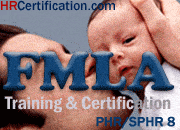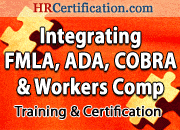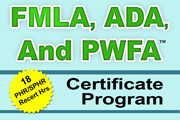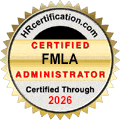FMLA Rules For Employers
What Is The FMLA – And What Are The Key FMLA Rules For Employers?
The FMLA stands for the Family and Medical Leave Act, a United States federal law enacted in 1993. It provides eligible employees with unpaid, job-protected leave for certain family and medical reasons.FMLA leave rules require certain employers to allow eligible employees to take unpaid, job-protected leaves for certain family and medical events, such as:

- Birth of a child
- Placement of a child for adoption or foster care
- Care of a spouse, child, or parent with a serious health condition
- Inability of the employee to perform the functions of his or her job because of a serious health condition
- "Qualifying exigency" (managing family affairs related to certain family members being on active duty or being notified of an impending call or order to active duty, or being deployed or called to deployment to a foreign country)
What Are The Most Common FMLA Requirements?
Here are some of the most common FMLA requirements:- Eligibility:
To be eligible for FMLA leave, employees must work for a covered employer and meet certain criteria, including having worked for the employer for at least 12 months, having worked at least 1,250 hours during the previous 12 months, and working at a location where the employer has at least 50 employees within a 75-mile radius. - Qualifying Reasons:
FMLA leave can be taken for specific reasons, including the birth and care of a newborn child, the placement of a child for adoption or foster care, to care for an immediate family member (spouse, child, or parent) with a serious health condition, or for the employee's own serious health condition that renders them unable to perform their job duties.
- FMLA Notice Requirements:
Employees must provide their employer with reasonable notice of their intention to take FMLA leave, including the anticipated duration of the leave, if known. In cases of planned medical treatment, employees are generally required to make reasonable efforts to schedule the treatment so as not to unduly disrupt the employer's operations. - Certification of Need:
Employers may require employees to provide certification from a healthcare provider to support the need for FMLA leave, particularly in cases of serious health conditions. - Duration of Leave:
Eligible employees are entitled to up to 12 weeks of FMLA leave within a 12-month period for most qualifying reasons. However, leave for the birth, adoption, or foster care placement of a child may extend up to 12 months from the date of birth or placement. - Job Protection:
Employees who take FMLA leave are generally entitled to be restored to their original position or an equivalent position with equivalent pay, benefits, and terms of employment upon returning from leave.
What Are Some Key Elements To FMLA Administration?
FMLA administration requires compliance with specific FMLA leave rules. Make sure your FMLA Administrator takes an FMLA training course to learn about the FMLA leave rules for employers, which include:- Notice Requirements
- Eligibility Determination
- Medical Certifications
- Leave Entitlement
- Job Restoration
- Continuation of Benefits
- Benefits Restoration
- Intermittent and Reduced Schedule Leave
- Paid and unpaid leave options
- Anti-Retaliation Provisions
- Compliance with state and local Laws
- Coordination of FMLA with ADA, COBRA, and other leave laws
- Fitness-for-duty testing
- FMLA Return-to-Work options
- How to identify FMLA - abuse and the individuals you need to involve in an internal investigation
- Recordkeeping
What Are FMLA's Medical Certification Requirements?
Under certain circumstance, employers can require employees to provide certification from a healthcare provider to verify the need for FMLA leave due to a serious health condition affecting the employee or a covered family member. Note: as with a lot of the FMLA compliance requirements, there are tricky rules here, so make sure you are properly trained in this area.
Key Issue:
What Is FMLA Intermittent Leave? How Does FMLA Intermittent Leave Work?
FMLA law allows FMLA leave to be taken intermittently or on a reduced schedule basis. While this is a legal requirement, it does create problems for administration, and is often the cause for FMLA fraud and abuse. For instance, what if an employee consistently requests Friday for FMLA leave. Could it be needed and factual, or abuse? It could be both, so FMLA administrators need to know how to handle these requests properly.
Key Issue:
Is FMLA Fraud And Abuse Prevalent?
Many employers have to deal regularly with potential FMLA fraud and abuse. For example, is it a true need or a coincidence that someone always calls out to take FMLA leave on Mondays? FMLA administrators need to know how to handle these requests properly - including how to deny.
What Are The Key Concerns / Most Difficult Part Of FMLA Administration?
- Interpretation of Eligibility:
Determining whether an employee is eligible for FMLA leave can be complex. Employers must understand the eligibility criteria, including the number of employees in the company and the employee's tenure. - Tracking Leave Entitlements:
Keeping accurate records of an employee's FMLA leave entitlement, including how much leave they have used and how much remains, can be challenging, especially for intermittent leave or leave taken in reduced schedules. - Managing Intermittent Leave:
Intermittent FMLA leave, where an employee takes leave in separate blocks of time, can be difficult to manage due to its unpredictable nature. Employers must track these intermittent absences carefully and ensure they are being used for valid reasons.
- Medical Certification and Recertification:
Obtaining and reviewing medical certification forms from healthcare providers to verify the need for FMLA leave can be complex. Employers must navigate privacy laws while ensuring the information provided is sufficient to support the need for leave. - Coordination with Other Leave Policies:
FMLA leave often intersects with other leave policies, such as sick leave, vacation time, or short-term disability. Coordinating these different types of leave while ensuring compliance with FMLA regulations can be challenging. - Employee Communication:
Communicating effectively with employees about their FMLA rights and responsibilities, including providing notices and explaining the process for requesting leave, can be challenging. Employers must ensure that employees are aware of their rights under FMLA without violating privacy or confidentiality. - Return to Work and Accommodations:
Managing an employee's return to work after FMLA leave, including any necessary accommodations or modifications to their job duties, can be complex. Employers must ensure a smooth transition back to work while complying with legal requirements. - Handling FMLA Abuse:
Identifying and addressing instances of FMLA abuse, such as fraudulent or excessive leave requests, can be challenging. Employers must balance the need to protect their business interests with respecting employees' rights under FMLA.
What Are The Most Common Errors Of FMLA Administration?
- Inaccurate Eligibility Determination
- Failure to Provide Notice
- Tracking Leave Entitlement
- Handling Medical Certification and Recertification
- Managing Intermittent Leave
- Failure to Properly Count FMLA Leave
- Not Providing Job Restoration
- Dealing with Return-to-Work and Accommodations
- Identifying And Handling FMLA Abuse

What Is The Benefit Of An FMLA Training?
FMLA training provides numerous benefits to both employers and employees. Here are some of the key benefits:- Reduced Liability
- Employee Satisfaction
- Retention
- Consistency
- Proper Recordkeeping
- Prevention of Abuse
- Cost Savings
FMLA training classes are the best way to ensure your FMLA administration efforts meet the FMLA rules for employers, or else your organization can be subject to fines and penalties. Look below for suggestions on the best FMLA training courses.
Recommended FMLA Training And Certification Courses
Below are a suggested online FMLA training course, an FMLA/ADA in-person seminar, and an online training course for integrating FMLA with other laws.- FMLA Training & Certification Program
- Certificate Program In FMLA, ADA, And The Pregnant Workers Fairness Act
- Integrating FMLA, ADA, COBRA, And Workers' Compensation Training & Certification Program
Excerpts From Our FMLA Training & Certification Program
Below are a couple of excerpts from our online FMLA training course.- What Are The FMLA Notice Requirements?
- For Which Family Members Can An Employee Take FMLA Leave?
- Eligible Types Of FMLA Leave
- We Don't Always Have 50 Employees. Is My Firm Subject To FMLA?
- What Exigent Circumstances Qualify For Family Leave?
- Return To Work Fitness For Duty Requirements
Helping To Understand The FMLA Leave Rules: Glossary Of Basic FMLA Terms
Term
Definition / Description
Bonding leave
FMLA taken to be with a newborn child, newly adopted child or a child recently placed for adoption or foster care. See also Family Leave.
Certification of Health Care Provider
Department of Labor Form WH-380 used by employers to have health care providers certify the existence of a serious health condition.
Coordination of Leave
The process of coordinating the rights and obligations of FMLA with existing employer leave policies including paid vacation time, annual sick leave, short-term disability and long-term disability benefits, workers' compensation, and other employer provided paid leave.
Disability Insurance
Income replacement insurance for employees that are unable to work due to non-work-related injuries or illnesses.
Employer Response to Employee Request for Leave
Department of Labor Form WH-381 used by employers to notify an employee whether their leave is FMLA qualifying.
General Notice
The term used to describe the requirement that employers provide written guidance for employees of the FMLA entitlements and obligations. The Department of Labor Fact Sheet on FMLA may be used for this purpose.
In loco parentis
A person with day-to-day responsibility to care for and financially support a child. A biological or legal relationship is not required.
Intermittent Leave
Leave taken in intervals for the same occurrence that are not consecutive.
Key Employee
A salaried employee who is among the highest paid 10 percent of employees that work within 75 miles of the facility where the employee taking FMLA is employed.
Leave Year
The 12-month period designated by the employer in which an eligible employee may take up to 12 weeks of FMLA. The employer must designate the leave year in writing and may choose from three options: a calendar year or any fixed 12-month period; the 12-month looking forward method; the “rolling” 12-month period measured backward for the date an employee uses leave method.
Light-duty
the process of performing a job that is physically or mentally less demanding than the employee's normal position. Typically used when an employee is recovering from an injury or illness and is not yet ready to return to his or her full responsibilities.
Medical Certification
See Certification of Health Care Provider.
Posted Notice
Department of Labor Model Notice to Employees of Rights under FMLA.
Preliminary Designation
The process of informing an individual that his or her time-off may be protected under the FMLA while facts regarding the time-off are being collected by the employer.
Recertification
The process of requiring an employee on FMLA to re-certify that the serious health condition still exists under the original terms and conditions or whether additional information will reduce or increase the amount of leave necessary.
Reduced Schedule Leave
FMLA taken for a fewer number of hours during the workday for which the employees is normally scheduled.
Retroactive Designation
The process of determining that time-off already taken should be counted as FMLA.
Serious Health Condition
An injury, impairment, physical, or mental condition that involves:
1. A period of incapacity in connection with or consequent to inpatient care in a hospital, hospice, or residential health care facility
2. A period of incapacity of more than three consecutive calendar days, that also involves treatment two or more times by a health care provider (or under the supervision of a health care provider
3. A period of incapacity due to disability related to pregnancy, or prenatal care
4. Chronic conditions requiring treatment by a health care provider
5. Long-term conditions requiring supervision
6. Non-chronic conditions that if left untreated could become serious
Specific Notice
The process of notifying an employee that his or her leave is FMLA qualifying. Employers may use DOL Form WH-381.
Workers' Compensation
Generally compulsory insurance that provides income replacement and health care benefits for injuries and illness that are job related.
Worksite
The single site of employment to which an employee is assigned or to which he or she reports.



